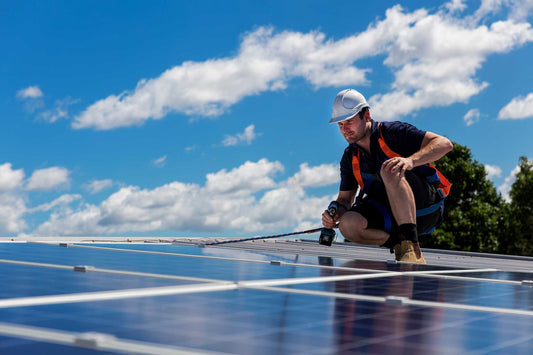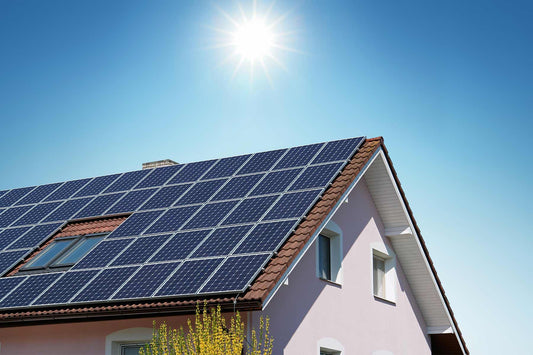As you watch solar panel systems pop up on rooftops all around your neighborhood, it’s natural to have some questions about this technology.
Why are solar panels so popular? What benefits do they offer? How much do they cost? Are there any discounts or incentives? How does installation work?
While going solar is easier and less expensive than ever before, it’s still a big decision that requires a lot of forethought.
To put your curiosity about solar panels to rest, we’ve compiled a comprehensive guide exploring everything you should know about this powerful tool for renewable energy generation. Read through our whole guide, or skip to the sections you’re most curious about below.
Table of contents:
- Why Install Solar Panels?
- How Do Solar Panels Work?
- How Much Do Solar Panels Cost?
- Before Going Solar
- Solar Installation Steps
- Solar Panel Maintenance & Safety
- Solar Panel Resources
- Solar Panel FAQ
Why Install Solar Panels?
With the huge popularity of residential solar panels in recent years, it’s natural to wonder, “What’s so great about them?”
Solar energy is a renewable source, meaning it never runs out — unlike fossil fuels such as oil and coal. Not only does this make it better for the environment, but it also makes it reliable. Homeowners can feel confident that they’re collecting and harnessing a never-ending source of energy to power their appliances.
When deciding whether to go solar, consider the pros and cons of solar panels below.
| Pros of solar panels | Cons of solar panels |
|---|---|
| Savings on electric bill | Upfront cost |
| Contribution to renewable energy | Patience required to see ROI |
| Home value improvement | Sun exposure requirement |
| Flexible payment options | |
| Tax benefits & incentives | |
| Independence from utility grid | |
| Long lifespan |
How Do Solar Panels Work?
It’s common knowledge that solar panels use sunlight to generate electricity, but how does this process work?
Solar panels are largely composed of semiconductors — a primary component used in computer chips. When sunlight makes contact with semiconductor cells, their electrons are released and their movements generate electricity, which then powers appliances or fills batteries. This process is called photovoltaics (PV).

How Much Do Solar Panels Cost?
You can expect your total system installation cost to land somewhere between $12,000 and $30,000 total before incentives. That said, with a low-cost leader like Solartap, you can expect to pay about 40% less, meaning your cost range will land between $7,200 and $18,000 before incentives.
You may be wondering why there’s such a large price range — this is because every system is different. There are several factors that go into every system, including component quality, your location, and your system’s size.
Before Going Solar

If you’ve decided that solar panels are right for you, there are some important steps to take before you start installing. We outline below what solar panel installation preparation should look like.
1. Analyze Costs and Savings
Before investing in solar, there are a lot of financial considerations to keep in mind, some of the most important being the system’s upfront cost and long-term ROI.
Since the cost of solar components and installation can induce some sticker shock, it’s a good idea to research national and local incentives that can bring the price of solar down.
The most popular and widely available of these incentives is the Federal Solar Investment Tax Credit (ITC), a tax credit offered by the federal government covering 30% of total solar system installation costs for installations completed between 2022 and 2032.
On average, solar panels pay for themselves in eight to 12 years. After this point, they are essentially generating renewable energy for free, meaning homeowners with solar enjoy 13-22 years of no electric bill.
2. Decide Whether to Lease or Own
When exploring options for going solar, you’ve likely heard of leases and PPAs, often coined “free solar.” These options involve renting installer-owned panels on your roof with little to no installation or component cost.
The idea of minimal upfront costs probably sounds very appealing, especially if your budget to go solar is tight. That said, it’s important to remember that with these options, you do not own the panels. The leasing company owns them and charges you to use them. This results in significantly lower ROI than if you were to purchase your own panels and start generating your own electricity.
If you’d like to own your own solar system but are worried about paying in full, consider a low-interest solar loan. This way, you can pay off your system over time and still reap a significantly higher payoff than if you were to lease your panels.
3. Map Out Your Property’s Availability
Even if you want to install solar panels, you have to do your due diligence and ask yourself, “Is my house good for solar panels?”
Unfortunately, not every property is perfectly positioned for solar panel installation. Sometimes, you have to get creative. Here are a few considerations when assessing your property’s suitability for solar:
- Roof position: Solar panels perform best when facing true south. If your roof doesn’t face south, that doesn’t mean your house is not qualified for solar — you may just need more efficient panels to meet your home’s energy needs.
- Roof space: Most solar systems will take up between 306 and 486 square feet on your roof. Whether it be due to chimneys, skylights, or limited space, not all roofs have the capacity to house an entire solar system. If this applies to you, consider installing ground-mounted solar panels or another solar installation method.
- Available land: In the event that the prospect of installing ground-mounted panels piques your interest, you must first measure out the available land on your property. If you don’t have enough open space for ground-mounted panels, you might want to explore other ways to go solar, like a community solar program.
Solar Installation Steps
Once you feel comfortable with your plan to go solar, you’re ready to move forward with installation. Below, we outline how to approach installation.
For a comprehensive DIY installation walkthrough, check out our step-by-step guide to installing solar panels.
1. Choose Your Equipment
Every solar panel brand has its own speciality, whether that be high efficiency, excellent durability, or low cost. Before choosing your solar panel brand and model, consider which factors matter most to you.
Apart from the panels themselves, you also need to decide on a type of inverter — options include a string inverter, a hybrid inverter, or microinverters. This decision will depend on the size of your system, your budget, your area’s shading, whether you install an energy storage system, and personal preference.
Generally speaking:
- String inverters are the most cost-effective options.
- Hybrid inverters are best for systems that use battery storage.
- Microinverters are best for maximizing system efficiency.
2. Determine System Size and Cost
After choosing your equipment, you’re ready to determine the size of your system and how much installation will cost.
Your system size depends on a variety of factors, including your energy usage, your panels’ efficiency, and how much sunlight your area gets. For the most accurate estimate, follow our step-by-step guide to sizing your solar system.
For a personalized estimate of your solar system’s cost, consult with an installer or try out our solar cost calculator today.
3. Plan Your Installation

There are several ways to install solar panels — you can have everything handled by your solar panel provider (a packaged “turnkey” installation), you can recruit installation help from an independent contractor, or you can make the entire installation a DIY project.
While turnkey installations are often seen as the most convenient options, they’re also by far the most expensive. Many full-service solar companies heavily mark up installation costs, often charging double the cost of the components themselves.
That said, if DIYing large technical projects like solar system installations isn’t your style, you can recruit help from a contractor.
With Solartap, an organized contractor installation feels just like a turnkey installation, but at a fraction of the cost. Get connected with a contractor in your area today.
4. Install the System
There are several stages of the solar panel installation process. These include:
- Mounting panels
- Wiring panels
- Installing inverter(s) and energy storage
- Connecting panels to inverter(s)
- Connecting everything to the grid
If you’re going the DIY route, be sure to check out our wiring diagrams. If you’re planning to source help from a contractor, they’ll walk you through their installation plan and will communicate everything they need to make the project a success.
Solar Panel Maintenance & Safety
Solar panels are relatively low-maintenance pieces of tech, but it’s still important to take good care of them to ensure they function effectively for years to come. Below, we discuss important considerations that go into solar panel ownership, including maintenance and safety around your system.
Maintaining Your System’s Health
For obvious reasons, solar panels need to be installed outside. Whether this is on your roof, on the ground, or on top of a detached garage, they are exposed to the elements, which leaves them vulnerable to some risks. Let’s unpack how to take good care of your panels once they’re installed.
Cleaning
Leaves, snow, and dirt are all too familiar to homeowners with solar panels. While these obstructions don’t totally impair solar production, over time they can collect and negatively impact your system’s efficiency.
Every six months to a year, it’s a good idea to hose down your solar panels and, if possible, gently scrub off any dirt that’s built up. If any animals have started nesting under or around your panels, contact an animal control specialist to have them removed and placed in a safe location. Otherwise, they may damage components.
Performance Monitoring
Many solar panel installers offer system monitoring services. If you can view your system’s output, it’s a good idea to check on performance regularly. Any significant dips might hint toward an issue that needs fixing, whether that be sun blockage or a malfunctioning component.
Inspecting
Solar panel manufacturers put their panels through rigorous testing to ensure they can withstand damage from severe weather conditions. That said, even the best equipment can malfunction.
If you notice your system’s performance has declined, it’s a good idea to have a technician visit your property and inspect your panels for any physical damage or component malfunctions. Fixing these quickly will keep your system operational for its entire lifetime.
Safety Considerations

Solar panels are generally very safe. Not only do manufacturers adhere to strict safety standards, but when panels are installed professionally, installers must also adhere to all local codes. That said, as with any other tool that produces an electric current, it’s important to take precautions when installing and maintaining your solar system.
During and after installation, remember the following:
- Exhibit caution when climbing your roof. If you aren’t totally confident in your ability to scale a roof and support yourself at the top, then call a contractor or technician to help. If you are, always have someone else present to support you and get help in the event of an emergency.
- Don’t step on solar panels. Solar panels are not built to withstand the weight of a person. You could break the panels or slip and injure yourself by attempting to walk on them.
- Don’t cut any wires. Electrical currents are almost always traveling through the wiring in a solar panel system. Cut or otherwise exposed wires can electrocute you or start fires. Be sure that all wires are properly insulated and avoid tampering with them.
- Don’t touch broken panel components. Exposed wiring isn’t the only part of a solar panel system that can hurt you. Solar panels are largely composed of glass and, if broken, should not be touched to avoid getting cut. Instead, call a technician to fix anything that appears broken.
- Maintain your distance from components. As a general rule, it’s a good idea to stay about 10 feet away from solar panels at all times. They are heavy pieces of equipment that produce electricity and can cause injury if precautions are not taken.
- Use protective equipment. In the event that you must lift solar panels, connect wiring, or touch any other components, it’s recommended to wear rubber insulating gloves and clothing that covers your arms and legs completely to keep you safe from electric shock.
Solar Panel Resources
As appealing as solar panels are, the upfront cost can deter some prospective solar customers. Thankfully, there are several government programs for solar panels as well as local initiatives that make solar more affordable and accessible. We describe some common ones below.
Solar Resources for Everyone
The Federal Solar Investment Tax Credit (ITC) is perhaps the most widely known and used government-sponsored incentive for going solar. Through 2023, the ITC provides a tax credit for homeowners who install solar systems, reducing federal tax owed by 30% the cost of the entire system installation.
There are also state government-sponsored programs encouraging solar panel installation, including property tax exemptions and more. Locate your state in the Database of State Incentives for Renewables & Efficiency (DSIRE) and search for incentives that apply to you.
In many areas, utility companies also offer net metering programs. Simply put, these programs allow you to trade some of the extra electricity your solar system produces with the utility grid. In exchange, your utility company gives you credits that bump down your energy bill.
Solar Resources for Low-Income Families
The majority of resources for low-income families interested in solar exist on a local or statewide level.
A couple examples include California’s Low-Income Weatherization Program (LIWP) and GRID Alternative’s Single-Family Affordable Solar Homes (SASH) Program.
- LIWP provides solar panel systems and energy efficiency upgrades to low-income households interested in reducing their energy bill as well as their carbon footprint.
- SASH not only provides qualifying low-income families with access to solar energy technology through financial incentives (such as rebates), but it also helps those families get trained for eco-friendly jobs.
As previously mentioned, you can identify your own state’s solar incentives in the DSIRE.
Solar Resources for Veterans
In addition to incentives that make solar more affordable, there are programs that support veterans’ transitions back to civilian life. Many of these are grouped under the U.S. Department of Energy’s Solar Ready Vets Network. They are as follows:
- Solar Ready Vets Fellowship Program: In areas where solar workers are in high demand, this program places active-duty military service members in classes that equip them to work in various areas of the solar industry.
- Solar Opportunities and Readiness (SOAR) Initiative: This initiative provides veterans with training, credentialing, and work opportunities in the solar industry.
- Cyberguardians and STEM Warriors: This initiative trains veterans in cybersecurity and IT, specializing in grid operations and other areas relevant to the solar industry.
Solar Panel FAQ
Solar panels are unlike any other energy production device — they’re renewable, homeowners regularly own them, and governments incentivize us to use them. We answer some common questions about this unique technology below.
Is My Home Suitable for Solar Panels?
Virtually every climate is suitable for solar panels. That said, not every home is positioned optimally for them. If your roof is really old or damaged, you may need to consider repairs before you can consider rooftop solar panels.
In the same vein, if your property is surrounded by trees that cast a shadow on your panels, they won’t produce nearly as much as they would if they had unobstructed sun exposure. Consider alternative mounting methods if you find that rooftop solar isn’t ideal.
Can I Install Solar Panels Myself?
DIY solar installation is doable, though it’s very important to know what you’re doing in advance. If you aren’t entirely confident in your ability to install solar panels yourself, reach out to a professional contractor for assistance.
You can also consider tag-teaming the job with a contractor, taking on parts of the installation while leaving others to a professional.
Are Solar Panels Worth It?
Yes — solar panels pay for themselves and provide massive electricity bill savings by the end of their lifetime. There are also numerous programs and incentives, such as the ITC, that make it easier and more affordable to invest in them.
How Many Solar Panels Are Needed to Run a Home?
To completely offset their total energy usage of 893 kWh per month, the average U.S. residential utility customer would need a 6.7 kW solar panel system. This comes out to somewhere between 17 and 27 panels, depending on panel efficiency among other factors.
Keep in mind that this only applies to the average American homeowner — your individual home size, energy use, and many other considerations go into how many panels you’d need to run your own home.
What Is the Price of a Solar Panel?
Solar panel price varies based on the manufacturer, the panel’s quality, the area you live, and more. On average, the panels themselves cost between $0.70 and $1.50 per watt, whereas a solar system installation costs between $2.50 and $3.50 per watt, or between $12,000 and $30,000 total.
Solartap makes solar panel planning and investment a breeze, cutting the cost of high-quality solar and connecting you with local contractors to get your system set up right.
Ready to get your own system up and running? Take a look at our residential solar panel offerings, or get a quote with our solar calculator today.





